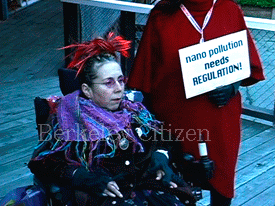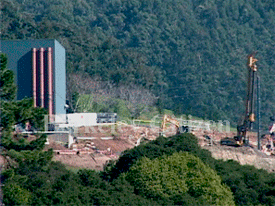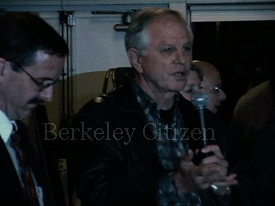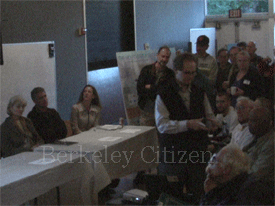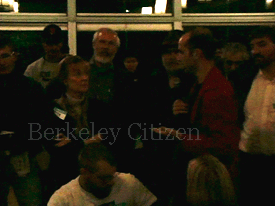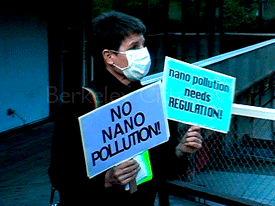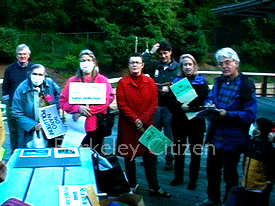
The HISTORY of the Lawrence Berkeley
National Laboratory Molecular Foundry
and the Berkeley Community
LBNL Long Range Development "Plan" and the Molecular Foundry (TMF)
The Laboratory failed to create a transparent, public process in the planning and construction of the Molecular Foundry in the City of Berkeley, and in the middle of a residential neighborhood, without a buffer zone. LBNL skirted the public process by issuing a negative declaration under the California Environmental Quality Act, (CEQA), rather than preparing an Environmental Impact Report (EIR) which would have allowed the community a formal public hearing on the project.
The Lab’s resistance to community involvement and any environmental process is reflective of LBNL’s and DOE’s continuing “cold war culture”. This is represented by the comments made by Lab attorney Nancy Ware, in response to community concerns about the lack of public process and an EIR for the Molecular Foundry; “An EIR would have been absurd, especially when we have an environmental document that says we don’t need one, “ Ware said. When further challenged about the need for an EIR, Ware stated, “So, sue us”. (Berkeley Daily Planet, May 13-15, 2003)
Flora Chow, Chemical Control Division, (7405M)
Office of Pollution Prevention and Toxics Environmental Protection Agency
1200 Pennsylvania Avenue, NW
Washington, DC 20460-0001Re: EPA proposal to regulate nanomaterials through a voluntary pilot program Docket ID: OPPT-2004-0122 EPA Docket Center, Rm. B-102 Reading Room EPA West 1301 Constitution Avenue, NW Washington, DC 20004
June 21, 2005Dear Ms Chow, We are providing these comments in response to the above referenced EPA proposal to regulate nanomaterials.
We endorse the comments already submitted by the Natural Resources Defense Council (NRDC) dated June 9, 2005 and would like emphasize the fact that EPA’s proposed voluntary program is inadequate and inappropriate.
In addition to the NRDC concerns we would like to bring to EPA’s attention the Berkeley community’s experiences from the past 2 1/2 years with the Lawrence Berkeley National Laboratory’s (LBNL) nanoscale research facility.
The Laboratory failed to create a transparent, public process in the planning and construction of the Molecular Foundry in the City of Berkeley, and in the middle of a residential neighborhood, without a buffer zone. LBNL skirted public process by issuing a negative declaration under the California Environmental Quality Act, (CEQA), rather than preparing an Environmental Impact Report (EIR) which would have allowed the community a formal public hearing on the project.
The Lab’s resistance to community involvement and any environmental process is reflective of LBNL’s and DOE’s continuing “cold war culture”. This is represented by the comments made by Lab attorney Nancy Ware, in response to community concerns about the lack of public process and an EIR for the Molecular Foundry; “An EIR would have been absurd, especially when we have an environmental document that says we don’t need one, “ Ware said. When further challenged about the need for an EIR, Ware stated, “So, sue us”. (Berkeley Daily Planet, May 13-15, 2003)
The Molecular Foundry is a Department of Energy (DOE) User Facility, which will operate without any local or state oversight. Our past experience with another LBNL User Facility, the National Tritium Labeling Facility (NTLF), now raises great concern for our community, again. For example, the NTLF was allowed to inventory and use up to 15,000 curies of tritium compared to the 150 curies in the inventory of the state’s regulated labs operating on the central UC Berkeley campus. Further, commercial pharmaceutical companies limited their tritium inventory to just 40 curies due to insurance/liability concerns. In fact, a local pharmaceutical company kept only 3 to 5 curies in their inventory.
But, just up the street, the NTLF operated as a commercial facility selling the use of their tritiation line to pharmaceutical companies. These companies were then able to come and utilize the kilocurie quantities of tritium in their experiments without being held liable for the potential environmental and health consequences of their experiments under the protection of DOE. If proper EIR/EIS environmental documents had been prepared in the early 1980s and our community offered an opportunity to comment on the NTLF project, the City of Berkeley and residential neighbors bordering LBNL could have been spared so much concern and contamination. Currently the NTLF operations have ceased but the Tritium contamination in the environment will remain for 125 years.
For the reasons stated above, we request that EPA, in the process developing regulations for nanotechnology, use special scrutiny with respect to DOE nanotechnology User Facilities and make them subject to all local and state regulations. The users of these DOE facilities should be made responsible for the environmental and health consequences of their experiments, like other commercial nanotechnology operations.
In conclusion, we are providing below the names and addresses of members of the Berkeley community who provided comments on LBNL’s Molecular Foundry, and others, and ask that you include them as stakeholders from our community to be updated on a regular basis on the development of regulations by US EPA on nanoscale materials.
Sincerely,
Pamela Sihvola, Co-chair/CMTW Berkeley, CA
L A Wood City of Berkeley’s Environmental Commission* *For identification onlyFoundry Opponents Claim Berkeley Lab Skirted Public Process
JOHN GELUARDI, Berkeley Daily Planet, May 13, 2003A meeting sponsored by Lawrence Berkeley National Laboratory (LBNL) was nearly derailed before it began Thursday night when a group of vocal citizens protested the meeting’s format, which they called a “dog and pony show.”
The meeting, which was billed as “A Conversation about Lab Activities,” was scheduled at the request of City Council to inform the public about LBNL’s plans to construct a six-story, 94,000-square-foot molecular foundry in Strawberry Canyon.
The construction of the foundry is estimated at $85 million, which will be funded by the Department of Energy. The foundry will be devoted to the study of nanoscience, the manipulation of materials at the molecular level.
The UC Regents approved the molecular foundry in March, and opponents contend they did so with insufficient public process and without an environmental impact report (EIR), which would have required a thorough examination of the plan and more lab response to community concerns.
Prior to the meeting, which was held in the Haas Clubhouse, about 25 opponents of the foundry held a press conference to call attention to what they described as LBNL’s unwillingness to include the public during the approval process. They also raised concerns about consequences of nanotechnology research.
Attending the press conference were members of the Community Environmental Advisory Group, the Peace and Justice Commission, the Committee to Minimize Toxic Waste and City Councilmember Dona Spring.
Lab officials argued that the environmental review that they did complete, known as a mitigated negative declaration, was sufficient and that the public had ample opportunity to comment on the foundry project prior to its approval.
To supplement the meeting, which began at 7:30 p.m., a series of information booths were set up to provide information about various lab projects such as energy efficiency research, canyon vegetation management and science education programs. The meeting’s focus, however, was the construction of the foundry and the nanoscience research that will be carried out there.
The evening began with the presentation of science achievement awards to three Berkeley High School students by Mayor Tom Bates and LBNL Director Charles Shank. Then, as discussion got under way, the proceedings were abruptly stopped by foundry opponents who demanded an opportunity to ask lab officials about the project. After several minutes of confrontation, the lab’s Community Relations Director Terry Powell assured the group they would have the chance to speak later during a question and answer period.
During the question and answer period, foundry opponent Janice Thomas expressed her concerns about lack of public process and the lab’s apparent reluctance to perform an ERI.
Her charges were challenged by LBNL attorney Nancy Ware.
“We made the negative declaration available on the Web and at public libraries and we extended the public comment period to 58 days when an EIR only requires 40,” Ware said. “An EIR would have been absurd, especially when we have an environmental document that says we don’t need one.”
Several people challenged Ware on the need for an EIR, saying the six-story foundry will have a huge impact on Strawberry Canyon, which is a habitat for the endangered Alameda Whip Snake and a watershed to city creeks.
“So, sue us,” Ware said.
The central issue to these types of LBNL research activities relate to the inability of the Lab to protect residents from potentially harmful airborne exposures from hazardous, radioactive or nano materials because the Lawrence Berkeley Laboratory essentially has no buffer separating any of its hillside research from our residential community.
Newsprint BELOW
- Molecular Foundry Foes Protest Groundbreaking
By MATTHEW ARTZ (01-30-04)- Foundry Opponents Claim Berkeley Lab Skirted Public Process
JOHN GELUARDI, Berkeley Daily Planet, May 13, 2003- Neighbors Slam LBNL Expansion
MATTHEW ARTZ, Berkeley Daily Planet
November 18, 2003
Molecular Foundry Foes Protest Groundbreaking
By MATTHEW ARTZ (01-30-04)
About 30 protesters withstood steady drizzle early Thursday morning, worried that once Lawrence Berkeley National Laboratory (LBNL) completes its newest laboratory complex, far smaller, more dangerous particles could rain down on them.“We don’t know anything at all about the health effects or environmental impact of what they’re doing here,” said Tom Kelly of the Community Health Commission.
This morning (Friday, Jan. 30), LBNL breaks ground on its Molecular Foundry. The six-story, 94,000-square-foot facility, financed by $84 million from the Department of Energy, will catapult the lab into the forefront of nanotechnology, one of the fastest-growing but least-understood disciplines of physics.
Nanoparticles are up to 100,000 times smaller than a human hair, but when properly manipulated, they have applications in every field from environmental preservation to repair of spinal tissues and creation of weapons of mass destruction.
Demonstrators assembled outside the lab’s entrance questioned how the new building—planned to sit just above a watershed 600 meters from an earthquake fault—could have evaded a rigorous environmental review. They doubted the lab’s capacity to keep nano-particles from escaping into air and possibly drifting into their lungs, and they questioned the lab’s will to keep potential contaminates from seeping into nearby creeks that feed the Bay.
“They’re wearing blinders on this project,” said Community Environmental Advisory Commission (CEAC) member LA Wood. “Not only do they not know the science, but they’re disregarding the environmental contamination of the hill.”
Last year the city council rejected CEAC’s call to request the lab perform an Environmental Impact Report on the project. Aware that nanotechnology is too new for an EIR to analyze potential inhalation risks, CEAC has called for the lab to hire an independent auditor to perform an annual review of the foundry’s operations, as well as clean up soil and ground water contaminated with radioactive tritium just uphill from the foundry sight and bar new construction while other buildings on their 200-acre Berkeley Hills campus remained vacant.
Lab spokeswoman Terry Powell has said in previous interviews that tritium levels were within federal standards and the lab would consider annual external reviews for work at the foundry.
Foundry Opponents Claim Berkeley Lab Skirted Public Process
JOHN GELUARDI, Berkeley Daily Planet, May 13, 2003A meeting sponsored by Lawrence Berkeley National Laboratory (LBNL) was nearly derailed before it began Thursday night when a group of vocal citizens protested the meeting’s format, which they called a “dog and pony show.”
The meeting, which was billed as “A Conversation about Lab Activities,” was scheduled at the request of City Council to inform the public about LBNL’s plans to construct a six-story, 94,000-square-foot molecular foundry in Strawberry Canyon.
The construction of the foundry is estimated at $85 million, which will be funded by the Department of Energy. The foundry will be devoted to the study of nanoscience, the manipulation of materials at the molecular level.
The UC Regents approved the molecular foundry in March, and opponents contend they did so with insufficient public process and without an environmental impact report (EIR), which would have required a thorough examination of the plan and more lab response to community concerns.
Prior to the meeting, which was held in the Haas Clubhouse, about 25 opponents of the foundry held a press conference to call attention to what they described as LBNL’s unwillingness to include the public during the approval process. They also raised concerns about consequences of nanotechnology research.
Attending the press conference were members of the Community Environmental Advisory Group, the Peace and Justice Commission, the Committee to Minimize Toxic Waste and City Councilmember Dona Spring.
Lab officials argued that the environmental review that they did complete, known as a mitigated negative declaration, was sufficient and that the public had ample opportunity to comment on the foundry project prior to its approval.
To supplement the meeting, which began at 7:30 p.m., a series of information booths were set up to provide information about various lab projects such as energy efficiency research, canyon vegetation management and science education programs. The meeting’s focus, however, was the construction of the foundry and the nanoscience research that will be carried out there.
The evening began with the presentation of science achievement awards to three Berkeley High School students by Mayor Tom Bates and LBNL Director Charles Shank. Then, as discussion got under way, the proceedings were abruptly stopped by foundry opponents who demanded an opportunity to ask lab officials about the project. After several minutes of confrontation, the lab’s Community Relations Director Terry Powell assured the group they would have the chance to speak later during a question and answer period.
During the question and answer period, foundry opponent Janice Thomas expressed her concerns about lack of public process and the lab’s apparent reluctance to perform an ERI.
Her charges were challenged by LBNL attorney Nancy Ware.
“We made the negative declaration available on the Web and at public libraries and we extended the public comment period to 58 days when an EIR only requires 40,” Ware said. “An EIR would have been absurd, especially when we have an environmental document that says we don’t need one.”
Several people challenged Ware on the need for an EIR, saying the six-story foundry will have a huge impact on Strawberry Canyon, which is a habitat for the endangered Alameda Whip Snake and a watershed to city creeks.
“So, sue us,” Ware said.
Neighbors Slam LBNL Expansion
By MATTHEW ARTZ, Berkeley Daily Planet
November 18, 2003Critics of the Lawrence Berkeley National Laboratory (LBNL) gave lab officials an earful Monday, arguing that planned expansion at the lab threatens to pollute their lungs, clog their streets and devour their tax dollars.
“The lab should never have been built there, but it doesn’t have to keep growing,” said Susan Cerny, a local preservationist.
The occasion of the complaints was a legally mandated Scoping Session that allowed the roughly 40 residents in attendance to weigh in on the Long Range Development Plan (LRDP) that will guide development at the 200-acre Berkeley Hills campus through 2025.
The plan projects increasing the daily population at the lab by 1,200 to 5,500 and boosting building space by 800,000 square feet to 2.56 million square feet.
Residents offered a litany of criticisms and suggestions that, by law, the lab must address in the Environmental Impact Report that will accompany the LRDP. Lab officials declined to address the speaker’s concerns, but said in private interviews that it would be difficult to satisfy them.
The lab’s most promising new field of research—nanotechnology—also proved its most controversial.
Nanoparticles are 100 times smaller than the width of a human hair, but when effectively manipulated exhibit dynamic properties that proponents say can revolutionize nearly every scientific field from medicine to weaponry.
Neighbors, though, fear the particles and fibers are so small that they’ll float through standard lab filters and land in their lungs, causing unknown health risks.
“Not even the Environmental Protection Agency knows the impact of these things, but we’re ready to let them loose in Berkeley,” said Tom Kelly of the Commission on Health.
Lab officials said most nanotechnology research has been performed in liquid solutions or with the particles bound to other materials—which sharply reduce the risk of emissions.
Residents called for a review of the future home for nanotechnology research—the Molecular Foundry— which they claimed lab officials snuck through environmental review before unveiling the long range plan.
Jeffrey Philliber, a lab facilities manager, said that since the foundry had already met all state environmental standards, it won’t be incorporated into the Environmental Impact Report—which, however, will address health concerns about nanotechnology.
On Tuesday, City Council tabled a recommendation from the city’s Community Environmental Advisory Commission to ask the lab to submit to annual studies on potential nanotechnology health risks from an independent board of scientists.
Other residents feared that the military would ultimately reap the benefits of the lab’s nanotechnology research, but lab spokesperson Terry Powell said only two percent of the lab’s budget is sponsored by the Department of Defense, none of it classified.
Many residents were just as concerned about the traffic heading to and from the lab.
Claiming that Centennial Drive and other commuter roadways were already carrying maximum traffic loads, neighbors urged the lab to work with AC Transit to establish bus service and establish an Eco Pass program to give incentives for workers to ditch their cars.
Powell said the lab planned to add just 600 new parking spaces for the projected 1200 new workers. But, he said, lab officials had previously rejected Eco Passes because many employees commute from Contra Costa County and therefore wouldn’t benefit from the program. The lab does run a shuttle service every ten minutes from downtown Berkeley.
“We can’t mitigate the traffic problem by ourselves,” Philliber said, citing a 1998 study that showed the lab accounted for a small portion of rush hour traffic heading through the South Berkeley Hills.
Lab officials were also quick to reject the city’s plan to seek compensation for city services, including maintaining sewers and access roads.
Powell said the lab already provides roughly $1 million annually to the city by fielding a fire department that provides first call service to neighborhoods around the lab. Last year, Powell said, the firefighters responded to 650 calls, 70 percent of them from off-campus neighbors.
Jeff Sherwood, spokesperson for the U.S. Department of Energy, said Department policy precluded it from paying Berkeley for services because the lab rents its property from the University of California.
Berkeley Assistant City Manager Arrieta Chakos said the city remained undeterred and would seek compensation either from the Department of Energy or the UC Board of Regents after staffers complete a report on the extent of the city’s expenditures towards maintaining the lab.
Meanwhile, the city is funding a study of expenses related to UC Berkeley, which is also in the process of finalizing its own Long Range Development Plan.
“It’s our responsibility to develop every type of avenue we can to work with the lab and campus,” Chakos said. “We really feel obliged to push this very early in the process.”
All Rights Reserved
